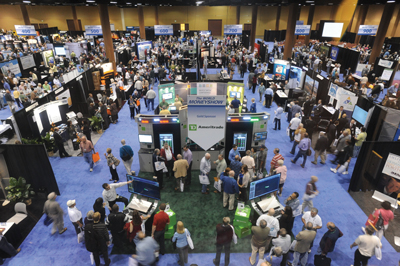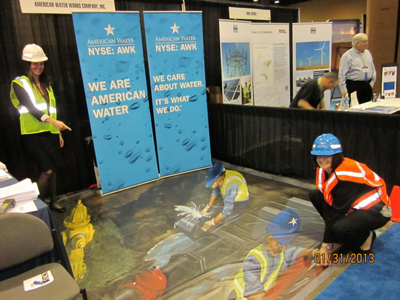Retail shows are a great way to build loyalty among private investors – as long as you have enough tchotchkes to go round
Pity the lowly retail investor. Shunned and ignored like a broken Ikea lamp, the investing masses languish in the communication shadows, unloved, under-appreciated – even mocked.
Battered by the tech bubble, many were washed away by the banking crisis. While some Wall Streeters murmur of their return to stock markets, grim realism about the US economy and prospects in Europe (along with less net worth) have muted individual investor enthusiasm for what many consider a rigged game.
Some companies seem to have written off these investors, yet others see value in establishing a relationship. While some IROs find efficiencies in launching a broker outreach program, others also like to roll up their sleeves and get in the trenches, mingling with the retail crowd – or to put it in a more politically correct way, the ‘self-directed investor’ crowd.
A good way to do this might be attending a retail investor conference. Several organizations in Europe and North America offer the chance to meet and interact directly with private investors. In many cases, public firms share exhibition hall premises with a variety of financial providers. Most conferences have an ‘educational’ outlook; all promise a range of marketing opportunities to help drive quality traffic to your booth.
 Alexander Justham, chief executive of the LSE |
‘Nothing can replace the ability to look someone in the eye as you shake his or her hand,’ says Lisa Campbell, director of Investor Conferences (UK), which organizes the London Investor Show in tandem with the London Stock Exchange. ‘It’s one of the best ways a smaller company can raise name recognition among investors.’
Kamie Zaracki, chief executive of BetterInvesting, which puts together several members-only retail conferences throughout the US, notes, ‘You can read all sorts of reports, but having that personal interaction with a company representative tends to make all the difference.’
‘Attending a retail investor show is a great way to build loyalty among retail shareholders, but you have to go in with reasonable expectations’ says Peter Block, a partner at National Public Relations. ‘A good presentation in front of a retail audience is unlikely to move the stock. You are building long-term loyalty and goodwill. As more firms seek shareholder approval, keeping the lines of communication open can be extremely beneficial to management.’
So why not show the love? IR Magazine asked a few seasoned IROs how they do it.
Show and sell: the busy exhibit floor at the MoneyShow
Booth & spiel
David Bujnicki, vice president of IR and corporate communications for Kimco Realty, has a pretty good spiel. He begins by asking booth visitors if they are familiar with Kimco. ‘We’re not Procter & Gamble,’ he admits.
Next he asks whether they are familiar with real estate investment trusts. Then he tells them that Kimco is North America’s largest owner and operator of shopping centers and that they’ve probably been to a Kimco shopping center and not even known it.
‘Then I’ll ask them where they live and I’ll pull out my book of shopping centers, point to one and say, Here – right in your neighborhood,’ Bujnicki continues. ‘That puts them at ease, and they say, Oh, I shop there all the time. And I say, Well, now you have a chance to own a piece of your neighborhood.’
After an easy introduction and a warm conversation (highlighted by the news Kimco has paid a yearly cash dividend since inception), visitors leave with a lighted pen, a fact sheet and the likelihood that each time they drive by the shopping center they will remember their chat with Bujnicki.
To help maximize the chance of that conversation, Bujnicki, perhaps not surprisingly, thinks strategically about exhibition booth placement. ‘People generally fan out from the entrance in a 45-degree spread,’ he observes. ‘You want to position yourself in a corner booth within that pyramid, where you’ll have good visibility from several angles. We also try to be around firms similar to ours or very well-known companies. You want a good anchor where you’ll get spill-over that will drive traffic.’
Bujnicki also warns against a pernicious malady that’s widespread among booth folk: the smartphone. ‘Ultimately, it’s vital to have a well-manned booth with people who look like they’re interested,’ he says. ‘If someone looks happy and engaging, that’s the best possible reason to approach. If someone is sitting, head down in his or her BlackBerry, there’s much less likelihood anyone will want to say hello.’
Getting traffic into the booth isn’t much of a problem for Muriel Lange, manager of IR at American Water. Besides her engaging personality, she’s got a nifty booth that sometimes features a 3-D floor mat showing engineers fixing underground water leaks. Investors don a hard hat and vest, Lange takes a snap of them peering into the ‘hole’, then she emails their photo along with a fact sheet. 
American Water’s booth at the MoneyShow took attendees below the surface
‘A lot of people don’t know what we do,’ says Lange. ‘We’re just another stock ticker. The booth puts them in the shoes of engineers to see what happens when there is a break in a main. It helps people understand that when they buy stock in our company they are providing capital that lets us invest in things like repair and replacement of water mains.’
Pretty much any IRO knows the tricks: smile, ask open questions, be interested. JoAnna Morris, director of corporate investor communications at GE, has been doing the retail show circuit for 23 years. She brings people closer by asking: what are you looking to invest in these days? ‘Begin by finding out what they are interested in,’ counsels Morris. ‘Conversations flow from there.’
Oh, the questions you’ll hear
Rehearsing a good spiel is important, but you’ll likely have to think on your feet when it comes to fielding investor questions.
‘The oddest questions tend to come up,’ says Lange, who recalls being asked why her company did not address water shortages by making more water. ‘You don’t always get the most sophisticated questions,’ she comments. ‘But sometimes you get dumb questions from institutions, too.’
‘You can be asked anything,’ adds Tom Burke, senior manager of IR at CVS Caremark. ‘You can have 200 conversations that point in 200 different directions. The diversity is amazing.’ In fact, Burke finds it tougher to prepare for retail show questions than those from the institutional side. ‘You know what the institutional guys will be focused on,’ he says. ‘But at a retail show you can get questions on virtually anything.’
Despite the vast potpourri of possible queries, some attempt to compile a list of the most likely. John Bey, president and CEO of Vancouver-based IR consultants SteelRose Communications, says, ‘Eighty percent of questions can be nailed down if you know your company and space. And if it’s over your head, don’t even try to answer it. Just get contact details and follow up.’
Bey and colleague Nancy Goertzen, principal at Nantucket Capital, put together an updated FAQ list before each conference. It includes questions such as:
- Why should I buy shares in your company?
- How is the stock doing? Why?
- How many shares/options do you have?
- Do you have any management people here I can talk to?
- I bought shares at $2 and now they’re down to a buck. (Not technically a question)
- How do you communicate with investors and what are your investor relations plans?
- Will you meet me for drinks?
Tchotchkes: the key to success
Financial journalists of a certain age fondly remember the golden era of ‘tchotchkes’, those little gifts that companies give to help keep their audiences on-side. It was a time when a visit to a really organized corporate office meant the provision of a swag bag for all the quality apparel, baseball caps, Swiss army knives and umbrellas most coveted by media operatives.
Alas, the intervening years have proved increasingly lean – so much so, in fact, that an airline-sized bag of branded candy (or two) now often suffices as a normal gesture of corporate goodwill. Well, you are shopping retail now, so be prepared to pay up.
‘The day the doors open is the day the locusts come through,’ says one veteran IRO and two-time MoneyShow attendee. ‘They are there for what you have on the table, and it might have nothing whatsoever to do with what your company is all about.’
Bujnicki can relate. After discovering his first wave of lighted pens had been scooped up within seconds, he decided to increase density by placing them in Kimco-branded coffee mugs. When the mugs disappeared, he used Velcro tape to attach them to the table. ‘I turn around and the next thing I hear is a ripping sound,’ he laughs.
Attendees wait with goodie bags at the London Investor Show
American Water’s tchotchkes are rubber ducks, and Lange brings hundreds. ‘A few hundred can be gone in the first hour. There’s never anything to ship home,’ she says.
‘It’s a double-edged sword,’ says Deborah Rossard, executive vice president of InterShow, which hosts the MoneyShow events. ‘Some people don’t want to hand them out like they used to.’
Still, a good tchotchke is an important weapon in your campaign to drive traffic to your booth and warrants more than passing consideration. ‘You want something that says, Come on over and say hello,’ says Bey. ‘We look for something unique that establishes a firm’s brand. Kids’ stuff is popular these days; people want things to bring back to their children. USBs with corporate presentations are another way to go.’
CVS Caremark hands out pill splitters. ‘We’ve done pens and magnet clips,’ says Burke. ‘But the demographics of these shows are skewed toward the older generation and people seem to really like the pill splitters. It’s a nice touch and there’s something to be said for having the company’s brand as a reminder of what they heard from you at the show.’
Get out in front to draw them in
Another effective method for driving traffic to your booth is to ensure either you or senior management participates in a panel discussion or other presentation opportunity during the conference. ‘It definitely generates more visits,’ says Burke. ‘You can get your ideas out to people early on and they can come to your booth better engaged and with more meaningful questions.’
Morris also values the technique. ‘You can’t really tell your story in five-minute conversations at your booth,’ she admits. ‘If we are going to spend money on one of these shows, we want to ensure we have the opportunity to present the company’s story to as large a group of investors as possible. Yes, that usually costs more, but the extra investment is worthwhile.’
‘The more you can do to put out more points of contact at these shows, the better,’ agrees Bujnicki. ‘Investors may have seen me on a panel, have become familiar with our company, and might have a follow-up question. You get name recognition and it makes people feel a little bit easier about approaching you.’
Most conference providers do a pretty good job of marketing their events – that is, after all, what you are paying them for. Some IROs will send out an email blast to their retail list; more ambitious ones will try to leverage well-timed CEO media appearances and other corporate events.
Afterwards, measuring success is hard – so hard, in fact, that few IROs attempt it. ‘It’s more of a philosophy,’ concludes Bujnicki. ‘Either you do it or you don’t. Reaching out to retail shareholders isn’t an easy task, but it can, in some ways, be very rewarding.
Try virtual National Retail Properties’ virtual booth at RetailInvestorConferences.com Not ready for the sensory overload, time and expense of a physical retail investor show? Want to put your news out closer to your own schedule? Some companies are turning to the internet with virtual meetings. PR Newswire’s Virtual Retail Investor Conferences, which can be found at RetailInvestorConferences.com, for example, offer the chance to present corporate information in real time, while eliminating travel and other expenses associated with physical events. After a welcoming presentation, companies have about 20 minutes to lay out their investment thesis. A Q&A is followed by firms making themselves available in a virtual ‘trade booth’ where investors can view additional material and chat in real time. Monthly presentations are archived and mailing lists are collected. ‘We aren’t replacing physical events,’ says Bradley Smith, director of marketing for PR Newswire’s IR and compliance solutions. ‘Face-to-face will always be important for some investors. We are another piece in the communications mosaic.’ The MoneyShow also features an e-show component as part of its exhibitor packages. InterShow’s Deborah Rossard says these follow-ups to the face-to-face show attract new investors as well as those who attended the event. ‘Just like our live shows, our e-shows feature quality programming that helps drive traffic,’ she explains. |










